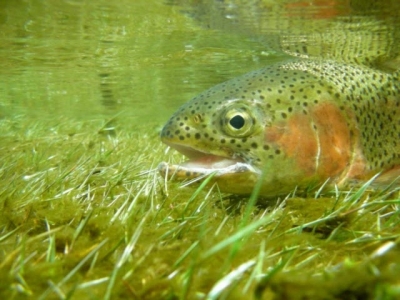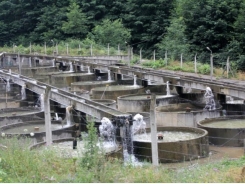Some mycotoxin mitigations may be less effective in fishfeed

Some types of feed additives developed to mitigate mycotoxins in feed for warm-blooded animals may be ineffective for fish, says new research.
A team of researchers at the University of Guelph’s fish nutrition research laboratory examined the use of one type of commercially available feed additives to mitigate the mycotoxin deoxynivalenol (DON) in the diets of rainbow trout (oncorhynchus mykiss). The group published its research in the journal Aquaculture.
“The objective of this study was, therefore, to investigate the potential efficacy of a commercial feed additive (CFA) with adsorbing and bio-transforming properties in minimizing or preventing the adverse effects of diets naturally contaminated with DON on growth performance and nutrient utilization of rainbow trout,” said the researchers.
The team found that use of an absorbing and bio-transforming commercially available mitigation product in trout diets did not improve fish performance.
“The feed additive used here was developed through extensive research and development with homeotherms; therefore, use in feeds for cold water fish species may be outside the scope of its effectiveness,” they said. “Additional work is essential to systematically develop novel approaches for mycotoxin mitigation in highly sensitive farmed fish species.”
Why mycotoxin mitigation?
Mycotoxins are a group of naturally occurring metabolites generated by some fungi and that produce negative effects in human and animals when consumed, said the researchers. Mycotoxin contamination stems from fungal infection of feed crops and is linked to environmental conditions during different stages of production and storage.
In general, mycotoxins are not removed during a routine feed manufacturing progress, they said. The contaminants are often linked to unspecific symptoms ranging from reduced production to mortality, and sensitivity to mycotoxins tend to vary based on several factors including animal species and age.
“It has been estimated that 25% of the world's crop production is contaminated with mycotoxins,” said the researchers. “The economic impact of mycotoxins is effectively impossible to quantify; however, risk assessment analyses have estimated that financial losses to US agriculture associated with crop losses, mitigation efforts and reduced livestock performance or mortality range from $630m to $2.5bn per annum.”
Mycotoxins often considered in relation to animal health include “aflatoxins, ochratoxins, fumonisins, zearalenone (ZON),” they said. The group also includes a set of compounds called the trichothecenes, which includes deoxynivalenol.
The expanding use of plant-based ingredients in aqua feeds has increased the potential for farmed fish to face mycotoxin exposures, they said. In a survey of carp feeds, 80% of samples were found to have detectable amounts of DON.
“Chronic feed-borne exposure to low doses of DON is commonly associated with anorexia (reduced feed intake and growth), decreased productivity and altered nutritional efficiency,” said the researchers. “Comparatively, acute, short-term exposure to higher concentrations of DON may result in leucocytosis, gastrointestinal hemorrhage, diarrhea and emesis or vomiting, particularly in pigs.”
Several important finfish species are considered to be highly sensitive to DON, they said. The presence of the mycotoxins in trout feed has been linked to reduced weight gain, limited thermal-unit growth coefficient (TGC), limited feed intake and feed efficiency, along with reduction in carcass crude protein content, retained nitrogen, recovered energy, nitrogen retention efficiency and energy retention efficiency.
Feed additives are often used in feeds to mitigate the negative influence of mycotoxin presence, they said. Additives can be absorbing agents, like clay minerals or yeast cell wall extracts, or bio-transforming agents, such as bacteria, fungi, yeast and enzymes.
These products have been studied in several terrestrial, monogastric species, they said.
However, most of the work looking at mitigation products in fish feeds has examined the use of clay-based mineral products, they said. Little work has been done examining the use mycotoxin mitigation products that act through absorption or biotransformation.
Methods and materials
In the study, 1,200 fish were given one of eight diets for a 12-week growth trial, said the researchers. The diets contained one of four levels of DON from naturally contaminated corn and were fed with or without the commercial feed additive (CFA).
Initial bodyweights were recorded and a sample of fish was collected to establish initial carcass composition, they said. During the study, feed intake was noted weekly and weights were taken every 28 days.
Fish were sampled at the end of the feeding trial to examine final carcass compositions, they said.
Diets, feed ingredients and fish tissues were checked for dry matter, ash, crude protein, lipids, gross energy content, they said. Growth rate, feed efficiency, retained nitrogen, recovered energy, nitrogen retention efficiency and energy retention efficiency were calculated.
Results
Use of the CFA to mitigate the mycotoxin was not found to be effective, said the researchers. Mortality was not altered by the experimental diets.
“Highly significant linear decreases in weight gain, feed intake and thermal-unit growth coefficient (TGC) were associated with increasing levels of DON in fish fed the diets with or without the CFA,” they said.
Fish getting the contaminated feed showed loss of whole body crude protein, lipids, ash and gross energy content, they said. With increasing levels of DON in the feed, the fish also had increased water content and both linear and quadratic decreases in retained nitrogen, recovered energy, nitrogen retention efficiency and energy retention efficiency.
“Inclusion of the CFA at the recommended rate (2 g/kg feed) did not minimize the adverse effects of diets containing increasing, graded levels of DON (up to 2.0 ppm) on growth performance, body composition or nutrient utilization of rainbow trout,” said the researchers.
No significant interaction was noted between DON and the use of CFA in the fish diets, they said. “Additional work is essential to systematically develop novel approaches for mycotoxin mitigation in highly sensitive farmed fish species,” they added.
Có thể bạn quan tâm
Phần mềm

Phối trộn thức ăn chăn nuôi

Pha dung dịch thủy canh

Định mức cho tôm ăn

Phối trộn phân bón NPK

Xác định tỷ lệ tôm sống

Chuyển đổi đơn vị phân bón

Xác định công suất sục khí

Chuyển đổi đơn vị tôm

Tính diện tích nhà kính

Tính thể tích ao hồ



 Increasing dietary carbohydrates may support fish growth with…
Increasing dietary carbohydrates may support fish growth with…  Optimal tryptophan levels boost tilapia weight gain, amino…
Optimal tryptophan levels boost tilapia weight gain, amino…